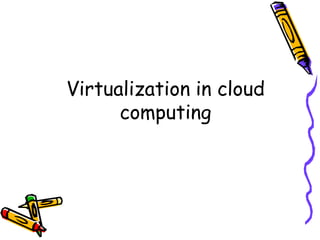
Cloud Computing Ppt
- 1. Virtualization in cloud computing
- 2. what is cloud? • Cloud computing is a pay-per-use model for enabling available, convenient, on-demand network access to a shared pool of configurable computing resources (e.g., networks, servers, storage, applications, services) that can be rapidly provisioned and released with minimal management effort or service provider interaction.
- 3. history The Cloud is a term that borrows from telephony Up to the 1990s, data circuits (including those that carried Internet traffic) were hard-wired between destinations. Then, long- haul telephone companies began offering VIRTUAL PRIVATE NETWORK (VPN) service for data communications. Telephone companies were able to offer VPN-based services with the same bandwidth as fixed circuits at a lower cost because they could switch traffic to thus utilizing their overall network bandwidth more effectively. As a result of this arrangement, it was impossible to determine in advance precisely which paths the traffic would be routed over.
- 4. economics • Cloud computing users can avoid capital expenditure (CapEx) • Consumption is usually billed on a resources consumed, like electricity or subscription (time-based, like a newspaper) • Other benefits of this time sharing approach shared infrastructure and costs, low management overhead, and immediate access to a broad range of applications. • In general, users can terminate the contract at any time.
- 5. characteristics • Agility • Cost • Device & location independence • Maintenance
- 6. Layers
- 7. Clients consists of computer hardware or computer software that relies on cloud computing for application delivery, or that is specifically designed for delivery of cloud services For example: Mobile Linux based iPhone, Microsoft based - Windows Mobile Application : A cloud application leverages cloud computing in software architecture, often eliminating the need to install and run the application on the customer's own computer, thus alleviating the burden of software maintenance, ongoing operation, and support. For example: Web applications(Webmail, Face book, Twitter, You Tube)
- 8. Platform : A cloud platform delivers a computing platform as a service, generally consuming cloud infrastructure and supporting cloud applications. It facilitates deployment of applications without the cost and complexity of buying and managing the underlying hardware and software layers For example: Solution stacks Java (Google App Engine PHP (Rack space Cloud Sites) Python Django (Google AppEngine) Infrastructure : it is the delivery of the computer infrastructure specially to the platform virtualization environment
- 9. servers The servers layer consists of computer hardware and/or computer software products that are specifically designed for the delivery of cloud services For example: Fabric computing (Cisco UCS)
- 11. • Public cloud • Hybrid cloud • Private cloud
- 12. • Virtualization: The ability to run multiple operating systems on a single physical system and share the underlying hardware resources
- 13. It’s terms • Platform virtualization • Partial virtualization • Storage virtualization
- 14. Virtualization in the Cloud • Enables multiple users to share the same hardware, but maintain separation based on data or application owner. • Management tools are giving you a “Enterprise View” of virtual environments. • Virtualization and Cloud Computing allow you to “fire” applications more rapidly, but does not improve an organization’s “aim”.
- 15. Traditional Server Concept Data base Email file server server
- 16. The Traditional Server Concept • System Administrators often talk about servers as a whole unit that includes the hardware, the OS, the storage, and the applications. • Servers are often referred to by their function i.e. the Exchange server, the SQL server, the File server, etc. • If the File server fills up, or the Exchange server becomes overtaxed, then the System Administrators must add in a new server.
- 17. The Traditional Server Concept • Unless there are multiple servers, if a service experiences a hardware failure, then the service is down. • System Admin can implement clusters of servers to make them more fault tolerant. However, even clusters have limits on their scalability, and not all applications work in a clustered environment
- 18. The Virtual Server Concept • Virtual servers seek to encapsulate the server software away from the hardware – This includes the OS, the applications, and the storage for that server. • Servers end up as mere files stored on a physical box, or in enterprise storage. • A virtual server can be serviced by one or more hosts, and one host may house more than one virtual server. • Virtual servers can still be referred to by their function i.e. email server, database server, etc. • If the environment is built correctly, virtual servers will not be affected by the loss of a host. • Hosts may be removed and introduced almost at will to accommodate maintenance.
- 19. Cloud computing takes virtualization to the next step • You don’t have to own the hardware • You “rent” it as needed from a cloud • There are public clouds – e.g. Amazon EC2, and now many others (Microsoft, IBM, Sun, and others ...) • A company can create a private one – With more control over security, etc.
- 20. How Cloud Computing Works • Various providers let you create virtual servers – Set up an account, perhaps just with a credit card • You create virtual servers ("virtualization") – Choose the OS and software each "instance" will have – It will run on a large server farm located somewhere – You can instantiate more on a few minutes' notice – You can shut down instances in a minute or so • They send you a bill for what you use
- 22. Thank you